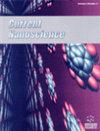A Facile Synthesis of Bimetallic Copper-Silver Nanocomposite and Their Application in Ascorbic Acid Detection
IF 1.5
4区 材料科学
Q4 BIOTECHNOLOGY & APPLIED MICROBIOLOGY
引用次数: 0
Abstract
Background:: An important antioxidant, ascorbic acid, must be detected in several industrial samples collected from food, pharmaceuticals, and water treatment plants. Herein, we reported a method to produce a bimetallic copper-silver (Cu-Ag) nanocomposite and used it in the development of very sensitive and selective electrochemical sensor for the detection of ascorbic acid. Methods:: A simple chemistry concept was used during the synthesis process to reduce the cost while minimizing the use of dangerous chemicals and minimizing the environmental impact. The Strobilanthes kunthiana leaves extract effectively reduced the copper and silver ions, resulting in the creation of an extremely stable and evenly distributed Cu-Ag nanocomposite. Results:: As-prepared bimetallic Cu-Ag nanocomposite exhibited outstanding electrochemical activity against ascorbic acid oxidation. The nanocomposite was examined using field emission scanning electron microscopy (FE-SEM), energy dispersive spectroscopy (EDS), elemental mapping (EMap) and X-ray diffraction analysis (XRD) to ascertain its composition, structure, and stability. Using cyclic voltammetry (CV), the electrochemical performance of the nanocomposite and also the detection of ascorbic acid were carried out. The bimetallic Cu-Ag nanocomposite also exhibited better long-term stability and fouling resistance, making it appropriate for use in real-world applications and complex sample matrices. Conclusion:: The bimetallic Cu-Ag nanocomposite coated electrode was used to detect the concentration of ascorbic acid by amperometry. As a result, this study offered a simple chemical method for creating a bimetallic copper-silver nanocomposite with superior electrochemical qualities for the accurate detection of ascorbic acid. conclusion: Its potential use as an electrochemical sensor for the detection of ascorbic acid opens doors for a variety of industries, including biological diagnostics, judging the quality of food, and environmental monitoring. As a result, this study offers a green method for creating a bimetallic copper-silver nanocomposite with superior electrochemical qualities for the accurate detection of ascorbic acid. The created nanocomposite has a lot of potential for improving ascorbic acid detection methods while upholding sustainable material synthesis. other: NA双金属铜银纳米复合材料的简易合成及其在抗坏血酸检测中的应用
背景从食品、药品和水处理厂采集的一些工业样品中必须检测一种重要的抗氧化剂--抗坏血酸。在此,我们报告了一种制备双金属铜银(Cu-Ag)纳米复合材料的方法,并将其用于开发检测抗坏血酸的灵敏度和选择性极高的电化学传感器。研究方法在合成过程中采用了简单的化学概念,以降低成本,同时最大限度地减少危险化学品的使用和对环境的影响。Strobilanthes kunthiana 叶提取物可有效还原铜离子和银离子,从而制备出极其稳定且分布均匀的铜银纳米复合材料。结果制备的双金属铜银纳米复合材料在抗坏血酸氧化方面表现出卓越的电化学活性。使用场发射扫描电子显微镜(FE-SEM)、能量色散光谱(EDS)、元素图谱(EMap)和 X 射线衍射分析(XRD)对纳米复合材料进行了检测,以确定其成分、结构和稳定性。利用循环伏安法(CV),对纳米复合材料的电化学性能和抗坏血酸的检测进行了研究。双金属铜银纳米复合材料还表现出更好的长期稳定性和抗结垢性,使其适用于实际应用和复杂的样品基质。结论双金属铜银纳米复合材料涂层电极被用于通过安培法检测抗坏血酸的浓度。因此,本研究提供了一种简单的化学方法来制造具有优异电化学品质的双金属铜银纳米复合材料,用于准确检测抗坏血酸:作为一种电化学传感器,它在检测抗坏血酸方面的潜在用途为生物诊断、判断食品质量和环境监测等多个行业打开了大门。因此,本研究提供了一种绿色方法,用于制造具有优异电化学品质的双金属铜银纳米复合材料,以准确检测抗坏血酸。这种纳米复合材料在改进抗坏血酸检测方法方面具有很大的潜力,同时也是一种可持续的材料合成方法:不适用
本文章由计算机程序翻译,如有差异,请以英文原文为准。
求助全文
约1分钟内获得全文
求助全文
来源期刊

Current Nanoscience
工程技术-材料科学:综合
CiteScore
3.50
自引率
6.70%
发文量
83
审稿时长
4.4 months
期刊介绍:
Current Nanoscience publishes (a) Authoritative/Mini Reviews, and (b) Original Research and Highlights written by experts covering the most recent advances in nanoscience and nanotechnology. All aspects of the field are represented including nano-structures, nano-bubbles, nano-droplets and nanofluids. Applications of nanoscience in physics, material science, chemistry, synthesis, environmental science, electronics, biomedical nanotechnology, biomedical engineering, biotechnology, medicine and pharmaceuticals are also covered. The journal is essential to all researches involved in nanoscience and its applied and fundamental areas of science, chemistry, physics, material science, engineering and medicine.
Current Nanoscience also welcomes submissions on the following topics of Nanoscience and Nanotechnology:
Nanoelectronics and photonics
Advanced Nanomaterials
Nanofabrication and measurement
Nanobiotechnology and nanomedicine
Nanotechnology for energy
Sensors and actuator
Computational nanoscience and technology.
 求助内容:
求助内容: 应助结果提醒方式:
应助结果提醒方式:


